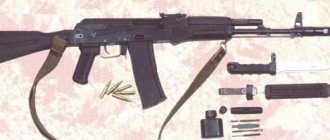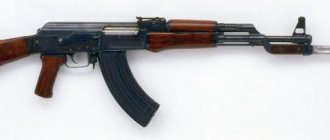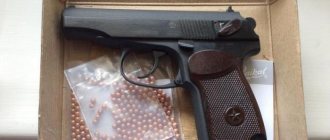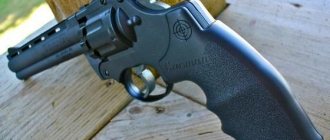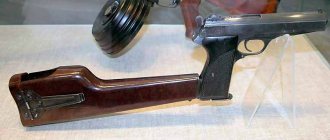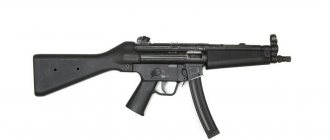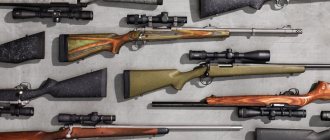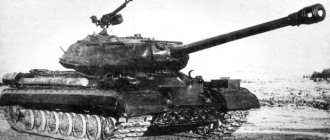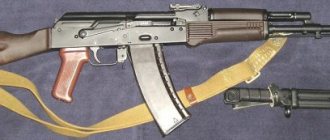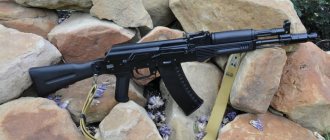One of the most popular entertainments for men, and not only, that can “accelerate” the adrenaline in the blood is, of course, airsoft. The popularity of airsoft is determined primarily by its physical component. In airsoft you have to run and jump, which requires certain sports training. Plus, you can “fight” with the whole family. The best choice for a novice “soldier” would be an AK series airsoft machine gun. Our article will tell you which one is better to buy. The editors of the YaNashla website have prepared for you a review of the best AK-series airsoft assault rifles for 2022.
Automatic AEK-971 A-545 6P67 6P68 (Russia)
Caliber: 5.45x39mm (AEK-971, 6P67) and 7.62x39 (AEK-973, 6P68)
Fire rate: 800-900 rounds per minute
Magazine: 30 rounds, standard from AKM and AK-74 respectively. caliber
The AEK-971 assault rifle was developed in the 1980s at the Kovrov Machine-Building Plant (KMZ) under the leadership of S.I. Koksharov as part of the Abakan competition program. The design feature of the AEK-971 is a balanced automatic circuit based on a gas engine (similar to the AK-107/108 assault rifles). With this scheme, an additional gas piston associated with the countermass moves synchronously with the main one, which moves the bolt frame, but towards it, thereby compensating for the impulses that arise when the bolt group moves and when it hits in the rear and front positions (it is no secret that one of design features of Kalashnikov assault rifles, which ensured high reliability of the weapon - the moving parts of the automation reach extreme positions at a significant speed, and therefore, when the bolt group moves, the assault rifle receives significant and multidirectional impulses of movement, negatively affecting the accuracy of automatic fire). As a result, the shooter only feels the recoil impulse when firing, and the machine gun does not twitch when firing in bursts, but seems to stick to the shoulder. Thus, in the AEK971 assault rifle it was possible to achieve automatic firing accuracy that was 2 or more times better than that of the AKM or AK-74 assault rifles (when firing from the AEK973 7.62mm caliber and the AEK971 5.45mm caliber, respectively).
The AEK-971 automation is built according to a gas exhaust system with a long stroke of the gas piston and an additional balancer, which has its own second gas piston moving in the opposite main direction. Synchronization of the bolt frame and balancer is carried out using a gear located vertically between them. The barrel is locked using a rotating bolt, similar in design to the bolt of the Kalashnikov AK-74 assault rifle. The trigger mechanism ensures firing with single shots, bursts of 3 shots and continuous fire, while the safety switch has a more convenient configuration than on Kalashnikov assault rifles; on serial models of different years of production it is located only on the left side of the weapon or on both sides. The accessories of the AEK-971 assault rifles are made of impact-resistant plastic, the weapon is equipped with a folding or sliding telescopic butt. On the receiver of the machine gun there is a seat for installing brackets for optical or night sights; it is also possible to install GP-25 or GP-30 under-barrel grenade launchers. Early release variants had open sights with an adjustable rear sight having a U-shaped slot. The 6P67 variant, presented for the Ratnik competition, has a sliding telescopic butt, a rotating diopter rear sight and a Picatinny-type guide integrated into the receiver cover for attaching day and night sights.
Based on the results of the test program at the end of 2014, it was announced that the A545 / 6P67 and A762 / 6P68 assault rifles, together with their competitor AK-12, had successfully passed tests and were recommended for mass production and extended military testing. According to available information. If military tests are successfully completed, both systems can be put into service in parallel, with weapons from the AEK family going primarily to troops and special forces units, and the AK-12 to regular line units.
Source
Equipment
The standard equipment of the AK 74 airsoft machine consists of additional magazines (4 pieces), a belt, and a cleaning rod. In addition, a battery and charger may also be present here.
Additionally, this variation of the weapon is equipped with a key for adjusting the front sight, through which you can create the most optimal conditions for shooting.
It should also be noted that there is an additional spring, which is capable of providing an initial shot speed of 120 m/s. Mandatory elements that should be included in the standard set are an instruction manual and a warranty card. The presence of the latter will allow the elimination of manufacturing defects in purchased weapons free of charge. Also, when purchasing, you must definitely require a quality certificate.
AEK 971 • Heap assault rifle for special forces
An interesting development by Kovrov designers: the AEK 971 assault rifle
Oh, master of sports in all sports Badyuk lit up. Is he now a weapons expert?
But I don’t like army guys who wrap Arab scarves around themselves. Fucking mods.
It was a long time ago when I disassembled a machine gun during NVP lessons, but nothing seems to have changed about that
where is the super complex mechanism that cannot be disassembled in the field?!
from the dark continent, ayyyy
“Special Rifle Company” of Major General Fedorov: Russian machine gunners of the First World War. Part 2
Many sources indicate that the company was equipped with 20 optical sights of the Goerz system. These sights were ordered by the optical workshop of the Obukhov plant back in 1914. It was not possible to establish exactly what model of sight was used, but a general idea of the appearance and characteristics of the “Hertz system” sights can be obtained from this pre-revolutionary catalog.
Here, after receiving 45 automatic (self-loading) rifles and eight submachine guns, the team began training. In July-August, the company conducted about a hundred shooting exercises, both at the shooting range and at the training ground, which had the nature of military tests.
In addition to direct fire training, they studied the equipment, weapon maintenance and ways to troubleshoot problems that may arise during shooting, practiced tactics, and learned to use various equipment.
And there was a lot of it, and it was the most modern for those years. The team was equipped with optical sights, binoculars, devices for shooting from behind cover, individual shooting shields, and Adrian's steel helmets.
Each submachine gun was supposed to have: 4 cartridge clips, 1 cartridge box, 1 leather bag with spare parts and accessories, 1 shooting shield. In the stowed position, each rifle and machine gun was carried in a special case.
Repairing one of the automatic rifles in the field. Judging by the ropes, they are gluing the cracked bed together.
The military viewed Fedorov's rifles and machine guns not as individual weapons, but as a replacement for light machine guns, the shortage of which was acutely felt in the Russian army.
Actually, the tactics of its use were based on this. Each weapon was serviced by a crew of two people.
The first number is the shooter, who directly fired; the task of his assistant was the timely supply of new stores and their equipment, as well as observation and adjustment of fire. If the first number was out of action, he had to replace it, for which he was also trained in handling the main weapon. The assistant was armed with a Mauser S-96 pistol for self-defense and to cover the shooter in close combat. All fighters, both shooters and their “understudies,” were armed with dagger bayonets, which were worn in metal sheaths on their belts.
Reconnaissance patrol. A shooter with a Fedorov rifle with a Madsen magazine conducts reconnaissance of the area using binoculars. The second number of the crew covers him, armed with a Mauser pistol. The photo was most likely taken in the Carpathians, 1917.
Speaking of tactics, we can assume that our military adopted it from the French, who used their Shosh light machine guns in a similar way. Moreover, Fedorov had the opportunity to observe their action on the French front.
There, too, each “machine gun” was served by two soldiers - a shooter and an ammunition carrier. The Germans followed the same path later when they adopted the MP-18 submachine gun. Thus, in all the warring armies, the first examples of automatic rifles and submachine guns were not yet in the full sense the individual weapon of a soldier.
Crew of one of the automatic rifles in position. The fighter in the foreground has a leather pouch for spare magazines and a bag of field binoculars.
On December 1, 1916, a “special forces team” or, as it was also called, an “automatic company” consisting of three officers and 150 privates went to the Romanian Front, where its native regiment fought as part of the 48th Infantry Division.
On January 13, 1917, a separate rifle company consisting of four officers and 152 privates arrived at the location of the Izmail infantry regiment.
The next day after the review by the regiment commander, the company's units were distributed among the battalions and went to positions. From this we can conclude that the company was used as a means of strengthening other units of the regiment. Unfortunately, at the moment there is practically no information about specific episodes of combat use of Fedorov automatic rifles.
The studied combat logs of the 189th Infantry Regiment for the period from January to September 1917 also do not contain separate references to the actions of the “automatic company” units in battles.
Most likely, this is again a consequence of the distribution of company platoons among the regiment's units. Therefore, it is reasonable to assume that they took part in the first battle in January 1917. What followed was the harsh everyday life of a positional war at the front, with constant shelling, earthworks to strengthen their positions and local skirmishes with the enemy.
The February Revolution, judging by the regimental journals, did not greatly disrupt the usual course of life of the regiment.
According to a report to the chief of staff of the 48th Infantry Division dated April 30, 1917, the separate rifle company consisted of 3 officers and 138 privates. Previously, this was considered the last documentary evidence confirming the existence of the unit.
However, it was possible to find a “Name list of military personnel of a separate rifle company, assigned to the 189th Izmail Infantry Regiment, who were apparently on short-term leave and business trips as of October 17, 1917.” According to this list, the number of the company was 118 officers and privates. One can only speculate about the further fate of the unit. It is most likely that it “dissolved itself” along with the rest of the Romanian Front.
Reply to the post “Why shouldn’t Russia copy the Italian law?”
In general, it happened as usual: he presented it haphazardly, and hoplophobes of various sorts came up with ideas within the framework of their picture of the world and started a record about “they will shoot everyone.”
Expressed in overseas categories (well, it just so happens that they are “trend setters” here), there are 2 main approaches to the issue under discussion:
1. Stand your ground - a doctrine according to which a person, in the event of an unlawful attack, has an unconditional right to counteract. Those. If the fact of encroachment (attack) is specifically established, then there are no legal consequences for the defender. Separately, it should be emphasized that it only works at the time of the assault; after it is over (the bully ran away/stopped) responsibility will be on a general basis. It is also worth noting that there is no concept of “a little encroachment”, as a result of which there is no “exceeding the measures of necessary defense”.
2. Duty to retreat - literally “duty to retreat.” Those. If, during an assault, a person has the opportunity not to increase the level of violence, then he is obliged to take advantage of it. In principle, if the investigation does not have an overt accusatory bias, then there is a certain logic, but it looks like shifting from a sore head to a healthy one.
In that region (in fact, like in our country at the moment) there was a combination of the first and second, i.e. in principle, it is possible to repel an encroachment, but you will certainly encounter the khutzpa about “a little encroachment” and the ensuing consequences of the second approach. So, the news says that they have finally moved to the first approach; what follows from this is stated above, and not what is written there in the comments.
Possible tuning
To improve the performance characteristics of this weapon model, it is recommended to take a certain set of measures. Through tuning, you can improve the range and accuracy of shooting. In this case, there is a need to implement certain design changes.
The power of a weapon directly depends on the stiffness of the spring, since it is this element that ensures the movement of the piston when fired. The power potential of the spring is also directly affected by the number of turns. Considering that this element can stretch over time, the procedure for replacing it is a vital necessity, and not a temporary upgrade.
It should be noted that installing a stiffer spring may result in a decrease in the rate of fire. To avoid this, it is recommended to use a higher voltage battery. Considering that energy consumption will be greater, it is necessary to install a battery with maximum capacity.
You can also carry out a set of work related to improving compression. To do this, you just need to install a thinner barrel with high-quality polishing of the inner surface. Moreover, such actions will improve shooting accuracy.
Why shouldn't Russia copy the Italian law?
It's about self-defense. About common sense.
Not so long ago, a new law was adopted in Italy, according to which “the defender is always right”; this has become an axiom. He does not need to prove his innocence to anyone, hire lawyers, spend a year and a half of his life in a pre-trial detention center (as was the case with Zobenkov), or raise a public outcry. Moreover, under the new law in Italy, the defender is also protected from claims for payments from the attackers and their relatives.
Now, a person who pulled the trigger “out of necessity to protect his right to life and property” is not considered guilty in any case. “The formula “defense is always legal” is becoming an axiom,” emphasizes its Roman correspondent Anna Buch on the pages of the Spanish La Vanguardia. “According to the initiators of the law, such a formulation of the issue will help reduce the number of crimes, in particular robberies, assaults, and burglaries.”
Also, the question is why in many countries you can safely purchase firearms, but not in Russia (we are not talking about hunting rifles)? After all, people are the same everywhere, there is no “special path” or mentality.
I remember when mass shootings occurred in schools and universities in the United States, our people said on TV that we would not have it like in the United States. “We have a special path,” they said. Then there were shootings in Russia.
So maybe now it’s worth legalizing firearms and adopting the Italian version of self-defense (at least in your home)?
Your opinion is interesting, comrades.
Advantages and disadvantages
This model of weapon, intended for playing airsoft, is characterized by maximum operational reliability. This is largely possible thanks to the metal body of the product. The presence of plastic parts allows us to minimize the weight of the machine.
In addition, the AK 74 for airsoft is popular due to its excellent performance characteristics. We are talking about a high initial speed of bullet departure, maximum accuracy and flight range. The rate of fire deserves special attention.
Among the shortcomings, we can note a small play in the forend, a low-quality battery, which is included in the basic package, and the possibility of the cleaning rod falling out. In addition, the plastic horn quickly becomes unusable.
Armory in forced self-isolation
Greetings dear! The children were sent on forced holidays. In connection with the above event, my child made a bunch of weapons out of cubes. What I took from the Internet, what I completed myself, this is what happened:
The shutter is made quite interestingly
Due to the lack of specific parts, it was not possible to make it 5-round.
The rifle was followed by a machine gun, somewhat similar to an AK.
Looks pretty good. for homemade!
Well, a pistol with a silencer for a snack!
Quite a massive thing with a removable magazine.
Bullets, balls, laser or plastic – what does an airsoft player shoot with?
Many beginners who have just come to airsoft or, as the game is also called - airsoft, do not fully understand what shells are used in airsoft weapons. Some people confuse airsoft with paintball or laser tag. In the first case, ordinary paint balls are used. In the second there is a laser. In airsoft, everything is a little different.
Airsoft weapons use plastic balls that differ in weight and color. If in paintball balls are used for standard paintball weapons, then in airsoft the ball is selected to match a copy of a real-life weapon. For example, for a pistol, machine gun or rifle. Therefore, in airsoft shooting is carried out with plastic balls of different diameters. Let's consider the parameters of the balls.
Diameter of shooting balls
There are two types of balls produced for airsoft weapons:
- 6 mm;
- 8 mm;
6 mm balls are used most often and are suitable for most types of weapons. 8 mm balls were created by manufacturers from Japan, who began to create large-caliber airsoft weapons. For example, one of the models is Marushin Anaconda MAXI8.
American special forces soldier and the Vityaz submachine gun
In fact, this is a Kalashnikov USA KP-9 pistol, which is based on the Vityaz. 10. (AKSU platform). In addition to pistols, it is produced in the version of a short-barreled rifle and just a rifle (KR-9). I believe they are powered by the same cartridges as ours - 9x19 Parabellum.
Mike Jones has owned it for over two months now and has ended up liking the product so much that he calls it one of the best guns he owns. However, there were some jokes about the special Russian approach. In his review, he noted that instead of developing its own SMG, Russia could have adopted the H&K MP5, but the Russians again went to reinvent the wheel, also using Kalash. He also installed the Delta Tek MPI-Vityaz sound moderator for the sake of the frenzy.
Laugh or laugh, but this blank completely hides the flash from the shot. By the way, along with the KP-9 and KR-9, KUSA also produces standard Vityazev mufflers, so making it as close as possible to the original is not a problem at all.
I was pleased with the bolt group - all in one piece, like in the PPSh. The fewer parts, the more reliable.
In terms of recoil, it is inferior to the MP5, but superior to it using the USM. No wonder - the MP5 has a semi-free roller action, still unsurpassed in the 9mm PP league (Mike's opinion). However, it causes a long trigger stroke. That’s why they make crappy pistols, unlike the Vityaz, which has a Kalashmat trigger that’s as sharp as diarrhea, and you can pull the hook much more often.
Mike replaced the original forend with a polymer forend made by Zenitka. They also have a laser target designator. I didn’t name the models, so I pulled up photos of the ones I found.
Unlike the PP-19-01, KUSA figured out to make the receiver cover with a Picatinny rail, so there was no need to buy separate guides in order to install a NATO standard collimator.
He says he had big concerns that the accuracy would be lousy, but the KP9 turned out to be one of the most accurate pistol carbines he has in his possession. From 120 yards (110 meters) it hits the silhouette without any problems.
Both American and Russian stores work fine with this gun. Mike prefers the American ones from the same KUSA, but the price is steep. He also liked that the magazines are installed more like an MP5 than an AK—you also have to pull the heel of the magazine a little to get it into place. Accordingly, I didn’t have to get used to/unaccustomed to it again. Another advantage of the KR9 over the MP5 is that the German is capricious about loading full magazines, and has to leave 28 rounds instead of 30, while the Americanized Russian does not have such a problem.
Zenitka RP-2 reload handle - I like it better than the standard one.
Mike’s cameraman also fell in love with this gun and bought it for himself, so during the filming of the review there were two Knights lying on the table at once.
This is how the AK-50 is made!
Mike Jones came to visit Brandon Herrera to film a video with a review of the prototype Kalashmat in .50BMG caliber. Since the video turned out to be quite short (24 minutes), I had the patience to watch it in full to satisfy my curiosity, otherwise Brandon filmed a shitload of videos during these 4+ years of development that I never finished watching.
Yes, it's really just a larger AK. First prototype of the second generation. Sounds like the first generation went into production, yeah! No, this is still the second generation of prototypes.
The return spring is standard, from a Kalash.
The trigger mechanism is also standard, it has not been touched at all.
M2 machine gun barrel, cut to 22 inches (56 cm). Brandon thinks that, ideally, it would be nice to have a 26-27 inch barrel (66-68.5 cm).
The muzzle brake was made by JMax. They actually stretched their RRD-4C model, designed for Kalash in 7.62x39 caliber, to .50BMG sizes.
What's funny is that the thread for it turned out to be completely opposite to the standard one. For AK it is a left 14x1, but here it is a right 1x14.
Parts such as the gas block, rear and front axles are naturally custom, because there are no other Kalash 12.7x99 in the world. But 12.7x42, by the way, exists. At least one, and Brandon made it too. XD
The gas tube was generally sharpened by hand on a lathe. Now it is only held on by electrical tape, because the fastening for it has not yet been made. Brandon says they tried both zip ties and a "tactical hose clamp," but in the end duct tape worked best because it stretches and doesn't break under impact like the first two options.
Regarding sighting devices, they plan to install optics, but it’s too early to think about it, we must first bring the gun to perfection. Mike jokingly suggested fitting Anti-aircraft gun mounts with Picatinny rails onto the forend and receiver.
To this, Brandon said that they have already looked at the solution used on the AK-12, and have also thought about a one-piece upper with a full-length Picatinny rail, but have no idea what will be on the final product. Perhaps they will try different options to come to a final decision based on practical research.
It shoots normally, we’ve even tried it from the shoulder, not just with a string. The recoil is a bit strong, but the muzzle brake does its job.
Designing both a gun and a magazine for it at the same time was a bad idea. As Mike joked, “When Kalashnikov designed the AK, did he think that this magazine release button would hold the load of a .50 BMG shot?” Actually, this standard button is one of the painful places, because the recoil sometimes causes an involuntary reset.
This also causes the cartridge to stick.
Minus 3 bucks. Or how much does he buy them there for?
Mike suggested strengthening the button spring, Brandon added that its angle could be changed.
Regarding the magazine capacity, we have so far settled on a 10-round option. Twice as much as the Simonov anti-tank rifle! XD
The first generation prototype used two parallel return springs, but in the second it was decided to try with one. They made a recoil buffer for her so that she wouldn’t vomit with the meat. Brandon thinks that this buffer currently has too much travel and needs a stronger spring.
The homemade bolt carrier works perfectly with the standard Kalash recoil spring. When the gas control is set correctly, when a 660 grain jacketed bullet is fired, it barely touches the buffer.
The bolt carrier with the piston looks epic!
Fun fact - the piston is attached to the bolt frame using a muzzle nut from a 7.62x39 Kalash rifle.
The bolt is very similar to the AK bolt, except that it is tri-lug (I wish I knew what that was).
In general, mass production is still a long way off, but at least the gun already works like a semi-automatic machine, independently chambering a cartridge after firing. I don’t remember whether there were plans for automatic fire, but it would have turned out to be a fierce mess! Enlarged RPK with a barrel from Ma-Deuce! XD
Forum "Army 2021". A few weapons interesting things. Part I
Good day, dear readers!
Your humble servant went to the Army 2021 Forum yesterday, August 27, and decided to share what interested him there. I must immediately make a reservation that everything described below was of interest to me, therefore I ask you to forgive me if for some of you what is stated is an open secret. I must say that at the annual forums in Patriot Park I am mainly interested in small arms, so most of the article will be devoted to them. I also have to apologize for the quality of some photos, because... The lighting in some pavilions is not at all conducive to photography.
In general, it must be admitted that compared to last year’s Forum, this year’s exhibition will be more modest - for example, the Kalashnikov Concern (hereinafter referred to as KK) did not have (at an open display, at a closed one) such samples presented in 2020, like the Chukavina sniper rifle and the RPL-20 machine gun; and other small arms manufacturers (TSNIITOCHMASH, ZiD) have fewer samples on display. But, nevertheless, the seeker will find, and something interesting is present.
I'll probably start with the exhibition of the Kovrov Plant named after. V. A. Degtyarev (pavilion 301 - a separate building with the inscription “High-precision complexes”)
I will not dwell in detail on the large-caliber sniper rifles (ASVK) and Kord machine guns presented there, RPG-7 and RPG-7D grenade launchers, etc.
But what I would like to focus on is the Kord assault rifles with balanced automatics 6P67 and 6P68 (the predecessors of which were known as A-545 and A-762, as well as AEK-971 and AEK-973).
General form. On the left is 6P67, on the right is 6P68.
The weapon is interesting because it implements the so-called principle. “balanced automatic” (the principle of its operation can be read at the link above), which is designed to compensate for the impulse created by the shock of the bolt in the rearmost position, which leads to increased accuracy and accuracy of automatic fire; The machines differ from each other only in caliber: 6P67 - chambered for 5.45x39 mm, 6P68 - 7.62x39 mm. They can use magazines from AK74 or AK-12 (6P67), as well as from AKM or AK103 (6P68).
Now to some details that interested me.
Firstly, plastic is very widely used in the design of weapons - the trigger body is entirely made of plastic, as is the receiver cover, the butt plate of the receiver, the forend, etc.
6P67, left view. 1- fuse - fire mode switch, 2- butt extension button, 3- place for attaching a swivel.
The safety-fire switch is double-sided, has 4 positions: safety, single fire, fire with a cut-off of 2 shots, automatic fire.
The forend is round in cross-section, with grooves for fingers; after AK it seems unusually thick (well, it’s a matter of taste))).
The sight is diopter, consists of a rear sight with a slider and a front sight. In addition, there is a Picatinny rail on the receiver cover. which has digital markings according to which various types of sights are installed.
The stock is retractable and extends by pressing a two-way button. Interestingly, the butt plate can be rotated both down and up; it is pulled back and turned over to the desired position. In the photo “General view” above you can see that if the top machine gun (6P68) has the buttplate turned with the lug down, then the bottom one is turned up.
Summarize.
AK-12 from Arcturus is a well-assembled steel drive, with a good level of copyability and an internal structure that is normal for a basic level. When compared with the AK-12 from LCT, the version from Arcturus confidently wins in three points at once:
- Better copyability compared to the combat prototype
- More convenient balance, in which the drive “pecks” forward less
- Price
As of December 2022, an AK-12 from Arcturus costs 22,555 rubles.
